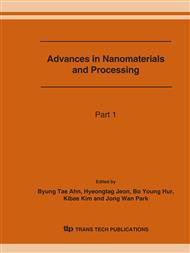p.731
p.735
p.739
p.743
p.747
p.751
p.755
p.759
p.763
Preparation and Characterization of Cordierite-Bonded Silicon Carbide Porous Ceramics
Abstract:
Cordierite-bonded silicon carbide porous ceramics were prepared by a reactive process, in which kaolin, talc, and alumina powders were mixed with silicon carbide powders and graphite powder was used as a pore former. The mixture was heated in air so that graphite was burned out and silicon carbide particles were bonded by reaction-derived cordierite. Open porosity and strength of porous ceramics were strongly dependent on the volume fraction of graphite and cordierite. A three-point bending strength of 13.9 MPa was achieved at a open porosity of 38.5 %, exhibiting coefficient of thermal expansion of 7.28 × 10-6/oC at the range of 25 – 800oC. Increase of cordierite volume in SiC matrix indicated mechanical improvement of the porous ceramics due to the increase of neck area among the SiC particles. Porous ceramics sintered at 1450oC possessed higher open porosity and median pore diameter than those of samples sintered at 1250 and 1350oC, since pore generated by the transport of dissolved talc materials as increasing temperature.
Info:
Periodical:
Pages:
747-750
Citation:
Online since:
June 2007
Authors:
Price:
Сopyright:
© 2007 Trans Tech Publications Ltd. All Rights Reserved
Share:
Citation:


